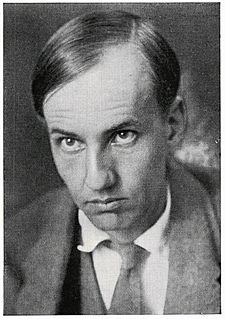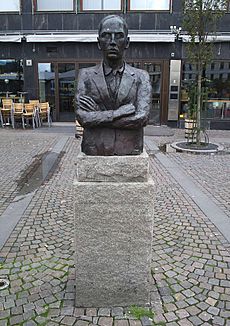Dan Andersson facts for kids
Quick facts for kids
Dan Andersson
|
|
|---|---|

Dan Andersson, 1917
|
|
| Born | Daniel Andersson 6 April 1888 Ludvika, Sweden |
| Died | 16 September 1920 (aged 32) Stockholm, Sweden |
| Occupation | Author, poet |
| Literary movement | Naturalism |
Dan Andersson (born April 6, 1888, in Ludvika – died September 16, 1920, in Stockholm) was a famous Swedish author, poet, and composer. He sometimes used the pen name Black Jim. He is known for writing about the lives of ordinary people, especially those in the working class.
Contents
Early Life and Beginnings
Dan Andersson was born in a place called Grangärde in the Dalarna region of Sweden. He grew up in the village of Skattlösberg, where life was often tough. His father, Adolf, was a primary school teacher, and his mother, Augusta, had also taught there.
The village was in an area known as the "Finn Woods." This is where people called Forest Finns had moved a long time ago to farm new land. Dan Andersson's family on his father's side came from these Finnish settlers.
As a young person, Dan Andersson took many different jobs. He worked in forestry and even as a school teacher. It was hard for his family to make enough money.
When he was 14, in 1902, his family thought about moving to the United States for a better life. Dan was sent to Forest Lake, Minnesota, to see if it was a good idea. But he wrote back to his family, saying that there were no better chances there than in Sweden. So, his father asked him to come home.
His family moved from Skattlösberg in 1905. However, Dan Andersson returned to live with his parents and siblings in Skattlösberg from 1911 to 1915. During this time, he wrote many of his well-known stories and poems. These include parts of his books Kolarhistorier (Charcoal Burner Stories) and Kolvaktarens visor (The Charcoal Watchman's Songs). In 1918, Dan Andersson married Olga Turesson, who was a primary school teacher.
Learning and Writing
From 1914 to 1915, Dan Andersson studied at the Brunnsvik folk high school. This was a special school where people could learn more about different subjects. He met other future authors there, like Harry Blomberg and Ragnar Jändel. He also became good friends with Karl Lärka, who later became a famous photographer.
After his time at Brunnsvik, Dan Andersson became a very active writer. He wrote poems and songs about his home region. Many of these are still read and sung in Swedish homes today, almost a century later. Musicians like Gunde Johansson and Thorstein Bergman are famous for performing his songs.
Dan Andersson also wrote music for some of his own poems. Two of his most famous songs are Till min syster ("To My Sister") and Jungman Jansson ("Sailor Apprentice Jansson"). He also played musical instruments like the accordion and violin.
From 1917 to 1918, he worked for a newspaper called Ny Tid in Gothenburg. He also translated books by famous authors like Rudyard Kipling and Charles Baudelaire into Swedish. Even though he grew up in simple conditions, Dan Andersson was very educated and talented.
An Early End
Dan Andersson died in Stockholm on September 16, 1920. He was staying in room 11 at Hotel Hellman because he was looking for a job at a newspaper called Social-Demokraten.
Sadly, the hotel staff had used strong chemicals to get rid of bedbugs and had not properly cleaned the room afterward. Dan Andersson was found dead at 3 p.m. that day. Another person, an insurance inspector named Elliott Eriksson, also died in the accident. The hotel building was later taken down in the 1960s.
Dan Andersson is buried in Lyviken Cemetery in his hometown of Ludvika.
His Lasting Impact

Dan Andersson's poems are still very popular in Sweden. People love them because they often talk about nature, mystery, and searching for meaning in life.
In 2005, a singer named Sofia Karlsson released an album called Svarta ballader (Black Ballads). It featured new versions of 11 of Dan Andersson's songs. This album won awards in both Sweden and Denmark. Before that, his poems had been sung by many other musicians, including the Hootenanny Singers and Fred Åkerström.
In 1988, to celebrate 100 years since his birth, the Swedish postal service, Posten, put his picture on two special stamps.
Every year, in the first week of August, people in Ludvika celebrate "Dan Andersson Week." There is also a museum dedicated to him in Ludvika, and a statue of him. Another statue of him can be found in Gothenburg.
Some of His Books
Dan Andersson wrote many books during his short life. Here are a few of them:
- Kolarhistorier (Charcoal Burner Stories) (1914)
- Kolvaktarens visor (The Charcoal Watchman's Songs) (1915)
- Svarta ballader (Black Ballads) (1917)
- Chi-mo-ka-ma. Berättelser från norra Amerika (Stories from North America) (1920)
|
See also
 In Spanish: Dan Andersson para niños
In Spanish: Dan Andersson para niños


